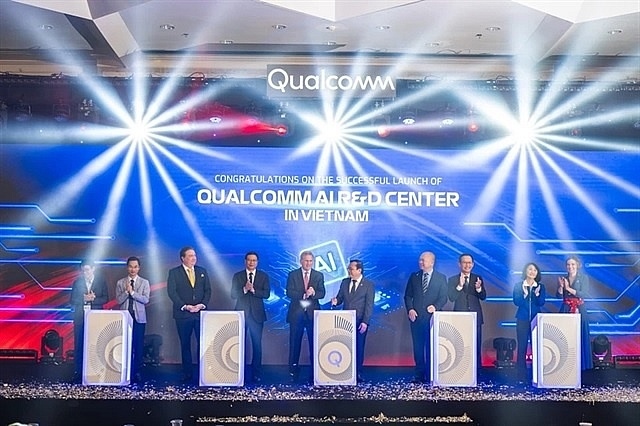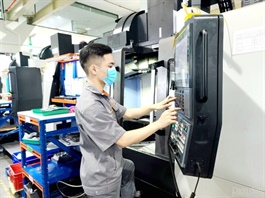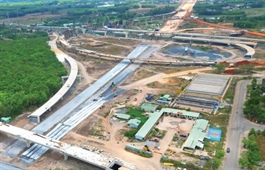Nation’s AI economy potential recognised
Nation’s AI economy potential recognised
With growing international partnerships and a robust talent pipeline, Vietnam is poised to become a regional leader in AI and semiconductor innovation, thanks to strong momentum in investment, applications, and economic potential.
Last week in Hanoi, Qualcomm Corporation launched a new AI Research and Development Centre in Vietnam, which is the third-largest centre in the world for Qualcomm, after two others located in India and Ireland. This project is expected to help Vietnam become a leading AI research and innovation centre in the region and globally.

The launching ceremony of the new Qualcomm AI R&D centre in Việt Nam on June 10. - VNA/VNS Photo |
The centre will play a role in developing generative AI solutions applied across many fields, such as smartphones, personal computers, extended reality, automobiles, and Internet of Things applications.
“The launch of the centre not only demonstrates a long-term commitment to supporting research and talent development in Vietnam, but also contributes to the journey of making Vietnam a centre for advanced technology innovation,” said Alex Rogers, president of Qualcomm’s Technology Licensing and External Cooperation.
“The level of Vietnamese AI experts is currently in the top 20 in the world, with numerous experts trained both domestically and abroad. This presents great potential for Vietnam to become a centre for AI and semiconductors in the region,” he added.
The centre is expected to directly contribute to Qualcomm’s global product roadmap and to the development of the AI technology industry in Vietnam.
Also last week, the Australia-Vietnam Strategic Technologies Centre, a new initiative to drive 5G/6G research, cybersecurity, and digital transformation, was launched. This aims to tackle the challenges and seize the opportunities of the digital future, and provide a dynamic platform for innovation, research excellence, policy leadership, and real-world applications in important and emerging technologies such as 5G/6G, AI, semiconductors, and cybersecurity.
According to a report on Vietnam’s AI economy, jointly released last week by the National Innovation Centre, the Japan International Cooperation Agency, and Boston Consulting Group (BCG), in 2024 the country ranked second among leading Southeast Asian countries in terms of the number of startups and investment capital in AI.
An important factor driving AI development is the growing IT and digital technology workforce, with more than 150 universities offering IT-related courses, and more than 60,000 students graduating each year.
The report highlighted three pillars that have directly promoted Vietnam’s AI economy, including the expansion of AI applications in both the public and private sectors, a growing AI ecosystem, and the development of a specialised workforce meeting international standards.
In addition to these pillars, supporting factors include improving general knowledge and awareness of AI, enhancing access to high-quality computing and data infrastructure, and having clear policies on sustainable AI development.
By 2030, AI is expected to contribute about $5 trillion to the global economy through increased revenue and cost reductions based on automation, data-based decision-making, and improved operational efficiency.
Arnaud Ginolin, head of BCG Vietnam, said that by 2040, AI will become a core factor in Vietnam’s economic growth, contributing $120-130 billion.
“Specifically, consumer revenue growth is projected to reach $45-55 billion, driven by demand for products and services with AI applications. Manufacturing could save $60-75 billion in costs through automation, predictive analytics, and improved efficiency using AI technology,” he explained.
In Vietnam, AI apps are becoming increasingly widespread. In agriculture, crop monitoring systems can detect pests, predict outbreaks, and recommend timely measures. In the environment sector, ecosystem monitoring systems using drones, cameras, and sensors track air, water, and wildlife in national parks.
Meanwhile, an AI chatbot can provide 24/7 travel information, offer personalised health services for vulnerable groups, and support and improve work performance in transport, education, justice, public security, finance, and much more.
However, to achieve the goal of building an AI economy by 2040, Nguyen Hoang Hung, chief technology officer of Viettel AI, identified three key areas: public administration, education, and healthcare.
“If we successfully use AI in education, it will create a breakthrough in human resources. And in healthcare, if it is successfully applied, it can eliminate the gap in the qualifications of doctors and nurses between upper-level hospitals and lower-level hospitals and healthcare facilities,” said Hung.
Recognising Vietnam’s potential in the AI economy, Qualcomm has committed to continuing its investment in the country, including nurturing Vietnamese talent in global AI development. The corporation is ready to cooperate with Vietnamese enterprises to build and develop the semiconductor and AI ecosystem in Vietnam, as well as to continue investing further, contributing to the country’s development.
Ginolin of BCG said that Vietnam is poised for an AI-powered leap, with numerous enablers driving its transformation and aligning it with global best practices. “Across industries, it is unlocking unprecedented opportunities for innovation, efficiency, and competitive advantage. However, true transformation demands a unified vision, where governments establish the framework, businesses drive implementation, and citizens embrace AI-powered progress,” said Ginolin.
- 10:10 17/06/2025























